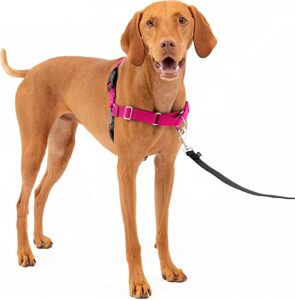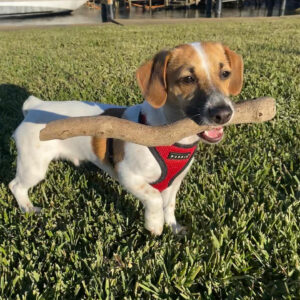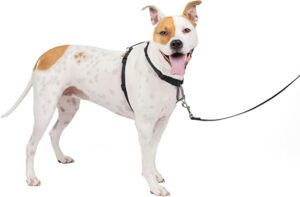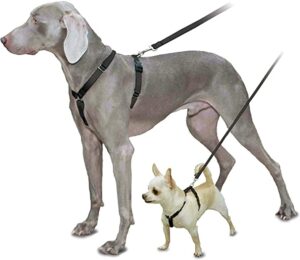Taking your dog on a walk is one of the most enriching parts of his or her day. It's also good for us humans too! A decision we need to make when we first adopt our furry friend is if we are going to teach them how to walk on a leash with a harness or collar. While there is much debate on if a collar or harness is better, there is plenty of evidence to suggest that harnesses are excellent ways of keeping your fluffy family member safe and secure on walks. Finding a harness that fits well is imperative to your dog's safety too.
How to choose the best and safest harness for your dog
Why are harnesses important?
While collars are generally okay for hanging around the house, harnesses are a safer option that offer more control for you as the owner. They’re also much easier on your furry family member than a traditional collar, as harnesses can alleviate back pain and reduce the likelihood of neck or throat injury. Unfortunately, prolonged use of collars in dogs that like to pull can lead to thyroid damage, spinal issues and quite a bit of discomfort. If you have a particularly keen dog that likes to pull, you might want to consider a harness. A good harness can help reduce pulling and stress on your pooch’s joints. Some types of harnesses are even engineered to discourage pulling. Harnesses also offer better control for you, as the owner, so you can both have a fulfilling, easy walk.
Harnesses should be considered for any dog with, or predisposed to the following issues:
- Brachycephalic/flat-faced breeds (e.g. pugs, bulldogs, Boston terriers)
- Breeds prone to back issues (e.g. dachshunds, basset hounds, corgis)
- Any dog with eye issues/glaucoma
- Any dog with past or present throat or neck issues
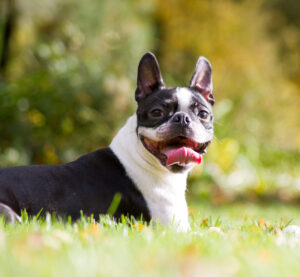
The front clip harness attaches to a D-ring at the centre of the dog’s chest. The pull point is closer to your dog’s centre of gravity, causing the pressure of the harness to spread out. When your dog tries to pull, he is then forced to face you, making it easier to steer him in the right direction and focus his attention on the owner (that's you!). The front clip harness is one of the most commonly used anti-pull harnesses because of how it passively discourages pulling.
The front clip harness, due to the increased amount of control it offers, is perfect for heavy pullers, and big dogs like boxers and huskies.
Back clip harnesses offer less control over your furry family members than the dual and front clip harnesses. These slide up the dog's front legs, and clip in at the back with a D ring to attach the leash. They are comfortable, easy to put on (your dog just has to step into the holes!), and they protect your dog’s neck. However, they’re not ideal for dogs in training, or dogs that have behavioural issues as they do little to discourage pulling.
If you have a brachycephalic dog, like a pug or a shih tzu, your pup might benefit from having a back clip harness. A harness that clips in the back rather than the front can reduce pressure on the throat region. Brachycephalics typically have short noses and muzzles, and undersized throats or breathing passages. Breathing for these dogs can be stressful, so it's important to fit them with the right harness that will make walks as easy as possible!
Back clip, or step-in harnesses, are ideal for calm or little dogs, such as jack Russells and Pomeranians, or brachycephalics, such as pugs and French bulldogs.
Dual clip harnesses have a front clip and a back clip for attaching your dog’s leash at two different points. If you want to use both clips at the same time, you have the option of using a double-leash adaptor. Otherwise, if you just want to use the back clip or front clip for anti-pull training, you can. A double leash attachment is an excellent option for greater control over larger breeds and energetic dogs. The dual clip is great because it adapts to suit your walking style. You can use the front clip when you’re deep in training to keep your pooch’s focus on you, then the back clip when you want to relinquish some control.
Dual clip harnesses are ideal for dogs in training due to the versatility they offer between the front clip and the back clip.
Y-shape harnesses are designed for comfort, and to reduce pressure on a dog’s neck and shoulders. The y-shaped design means that the strap at the front does not limit movement in the front legs. It's perfect for senior dogs, or those that have issues with their shoulders and necks, and need a little extra support. Due to the weight distribution, the y-shape harness keeps your pet’s neck and shoulders free from stress. This type of harness is perfect for fast-paced activities where less restriction is needed, or long walks and hikes.
The y-shape harness is ideal for senior dogs, dogs with shoulder or neck problems, and puppies, as they are highly adjustable.
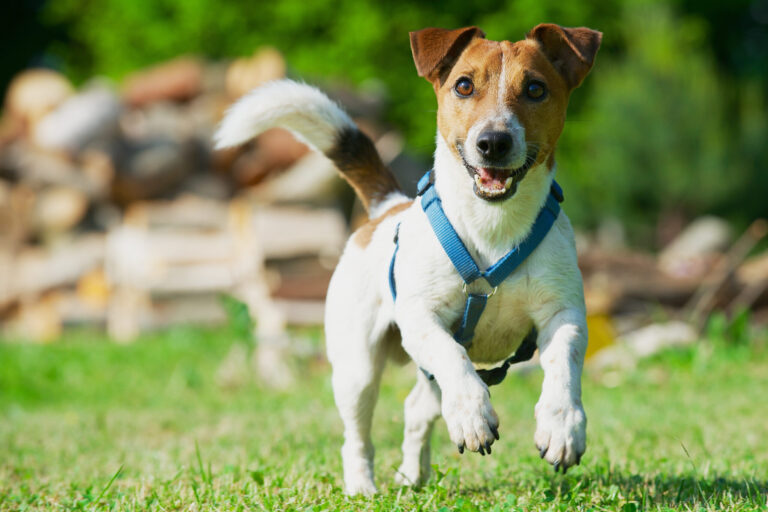
Durability
Can you adjust the fit? Does it have adjustable straps? Your pup’s harness should fit snugly. It shouldn't be so loose that they can wriggle their way out of it, and it shouldn't be too tight, either. Use the two-finger rule – if you can comfortably slide two fingers between your dog and the harness, it's a good fit.
Is the material cheap? This could be a sign the harness will deteriorate over time. If your pet has sensitive skin, make sure you opt for a material like neoprene, that is less prone to irritation.
Comfort
Does the harness put pressure on your dog’s neck or throat? Is your little guy visibly uncomfortable? Does he squirm around while wearing it? While it may take a bit of time to get used to the prospect of wearing a harness, the harness itself should be comfortable.
The harness should be made of a comfortable material, that can be worn for a decent amount of time. Many harnesses are made of soft polyester or nylon underlaid with soft neoprene, for the ultimate comfort factor (as well as quick and easy washing!).
Does it have padding? Many dogs with short fur benefit from padding in high friction spots (like chest, neck, and armpit) to prevent irritation. If this sounds like your pup, make sure you opt for some padding.
Cost
Is it in your price range? Your dog will probably wear the harness every time he or she goes on a walk. You should be getting your money's worth, and not have to replace it every few months. While it's perfectly fine to opt for a harness that's budget friendly, make sure the material matches the price point, and you’re not overpaying for a harness that will irritate your pup.
Final word
When considering which harness you should get for your pup, consider their breed and temperament. If your dog is a puller and has a large stature (like an Aussie Shepherd or a Boxer), they may be suited to a front clip. However, if your pooch is calm, doesn't really pull, and is a small breed (like a Jack Russell or Pomeranian), they may be well suited to a back clip or a step-in harness. Back clips are ideal for those owners that don't need as much control, whereas the front clips offer greater control and a design that can discourage pulling.

